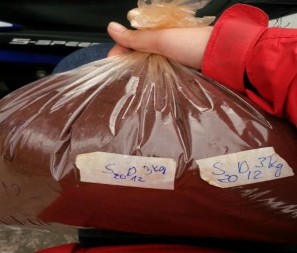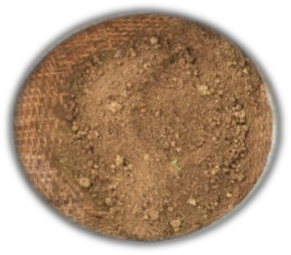hypogaea L. (peanut) and beneficial soil microorganisms: How much is it known? Critical Reviews in Microbiology, 36, pp. 179 - 194.
[67] Fan, B (2011), Study on high efective phosphate solubilizing and multifunctional biofertilizer in China. FNCA biofertilizer Newsletter. No. 9, pp. 5.
[68] FAOSTAT (2020) http://www.fao.org/faostat/en/#data/TP.
[69] Figueiredo, M., Bonifacio, A., Rodrigues, A., Araujo, F., and Stamford, N. (2016), beneficial bicroorganisms: Current challenge to increase crop performance, In "Bioformulations: for sustainable agriculture," (e. Arora et al., ed.), pp. 53 - 70, Springer, India.
[70] Figueredo M.S., Tenelli M.L., Ibánez F., Morla F., Cerioni G., Del Carmen Tordable M., and Fabra A. (2017), Induced systemic resistance and symbiotic performance of peanut plants challenged with fungal pathogens and co- inoculated with the biocontrol agent Bacillus sp. CHEP5 and Bradyrhizobium sp. SEMIA6144. Microbiological Research, 197, pp. 65 - 73.
[71] Florkowski, W. J. (1994), Groundnut production and trade, The Groundnut crop: A scientific basis for improvement (J. Smartt, ed.), Chapman & Hall, London, pp. 1 - 22.
[72] Ganesan, P., and Gnanamanickam, S. S. (1987), Biological control of Sclerotium rolfsii Sacc. in peanut by inoculation with Pseudomonas fluorescens, Soil biology and biochemistry, 19, pp. 35 - 38.
[73] Ganesan, S., Kuppusamy, R., and Sekar, R. (2007), Integrated management of stem rot disease (Sclerotium rolfsii) of groundnut (Arachis hypogaea L.) using Rhizobium and Trichoderma harzianum (ITCC-4572), Turkish journal of agriculture & forestry, 31, pp. 103 - 108.
[74] Garg, N, and Geetanjali (2007), Symbiotic nitrogen fixation in legume nodules: process and signaling. A review. Agronomy for sustainable development, 27 (1), pp. 59 - 68.
[75] Ghasemi, M., Mousanejad, S., and Mehdipour Moghaddam, M. J. (2017), Efficacy of peanut root nodulating symbiotic bacteria in controlling white stem rot, journal of crop protection, 6, pp. 191 - 205.
[76] Glick, B. R. (2012), Plant growth-promoting bacteria: Mechanisms and
applications. scientifica, pp. 1 - 15.
[77] Gnanamanickam, S.S. (2009). Biological control of rice diseases (Progress in Biological Control vol. 8), Springer Science Business Media B.V., pp. 67 - 78.
[78] Gomes, E. A., Lana, U. G. P., Quensen, J. F., de Sousa, S. M., Oliveira, C. A., Guo, J., Guimarães, L. J. M., and Tiedje, J. M. (2018), Root-associated microbiome of maize genotypes with contrasting phosphorus use efficiency, Phytobiomes Journal, 2, pp. 129 - 137.
[79] Govindasamy, V., M., Senthilkumar, V., Magheshwaran, U., Kumar, P., Bose, V., Sharma and K. Annapurna (2010), Bacillus and Paenibacillus spp.: Potential PGPR for Sustainable Agriculture, In: Maheshwari D.K. (ed.), Plant growth and health promoting bacteria, Microbiology Monographs 18, Springer- Verlag Berlin Heidelberg, pp. 333 - 364.
[80] Gupta, G., S.S., Parihar, N.K., Ahirwar, s.K., Snehi and V. Singh (2015), Plant growth promoting rhizobacteria (PGPR): Current and Future prospects for development of sustainable agriculture, J. Microb. Biochem. Technol., 7, pp. 96 - 102.
[81] Haggag, W. M., and Timmusk, S. (2008), Colonization of peanut roots by biofilm-forming Paenibacillus polymyxa initiates biocontrol against crown rot disease, J Appl Microbiol, 104, pp. 961 - 969.
[82] Hamdi, Y. A. (1982), Application of Nitrogen-fixing systems in soil improvement and management, FAO soils bulletin, 49.
[83] Harikesh B. S; Sarma, B. K., and Chetan, K. (2017), Advances in PGPR research. In "Advances in PGPR research" (Harikesh B. Singh, B. K. Sarma and Chetan Keswani, eds.), CAB International.
[84] Hayat, R., Ali, S., Amara, U., Khalid, R., and Ahmed, I. (2010), Soil beneficial bacteria and their role in plant growth promotion: a review, Annals of Microbiology, 60, pp. 579 - 598.
[85] Hussein, H. S., and Brasel, J. M. (2001), Toxicity, metabolism, and impact of mycotoxins on humans and animals, Toxicology, 167, pp. 101 - 134.
[86] Ibrahim, M. A., Griko, N., Junker, M., and Bulla, L. A. (2010), Bacillus thuringiensis: A genomics and proteomics perspective, Bioengineered Bugs, 1, pp. 31 - 50.
[87] Jangir, M., Pathak, R., Sharma, S., and Sharma, S. (2018), Biocontrol mechanisms of Bacillus sp., isolated from tomato rhizosphere, against Fusarium oxysporum f. sp. lycopersici, Biological Control, 123, pp. 60 - 70.
[88] Kishore, G. K., Pande, S., and Harish, S. (2007), Evaluation of Essential Oils and Their Components for Broad-Spectrum Antifungal Activity and Control of late leaf spot and crown rot diseases in peanut, Plant Dis, 91, pp. 375 - 379.
[89] Kishore, G. K., Pande, S., Rao, J. N., and Podile, A. R. (2005), Pseudomonas aeruginosa inhibits the plant cell wall degrading enzymes of Sclerotium rolfsii and reduces the severity of groundnut stem rot, European Journal of Plant Pathology 113, pp. 315 - 320.
[90] Kloepper, J.W., J., Leong, M., Teintze and Scroth, M.N. (1980), Enhancement of plant growth by siderophores produced by plant growth promoting rhizobacteria, Nature, 286: pp. 885 - 886.
[91] Kumar, A., Prakash, A., and Johri, B. N. (2017), Bacillus as PGPR in Crop Ecosystem, Bacteria in Agrobiology: Crop ecosystems (D.K. Maheshwari, ed.), Springer-Verlag Berlin Heidelberg 2011.
[92] Le, C.N. (2011), Diversity and biological control of Sclerotium rolfsii, causal agent of stem and pod rot of groundnut. PhD, Wageningen University.
[93] Le, C. N., Kruijt, M., and Raaijmakers, J. M. (2012a), Involvement of phenazines and lipopeptides in interactions between Pseudomonas species and Sclerotium rolfsii, causal agent of stem rot disease on groundnut, Journal of Applied Microbiology, 112, pp. 390 - 403.
[94] Le, C. N., Mendes, R., Kruijt, M., and Raaijmakers, J. M. (2012b), Genetic and Phenotypic Diversity of Sclerotium rolfsii in Groundnut Fields in Central Vietnam, Plant Disease, 96, pp. 389 - 397.
[95] Le, C. N., Hoang, T. K., Thai, T. H., Tran, T. L., Phan, T. P. N., and Raaijmakers, J. M. (2018), Isolation, characterization and comparative analysis of plant-associated bacteria for suppression of soil-borne diseases of field- grown groundnut in Vietnam, Biological Control, 121, pp. 256 - 262.
[96] Le, C. N., Thai, T. H., Nguyen, X. V. , Nguyen, T. L., Tran, T. X. P., and Tran,
T. P. N. (2019a), Biological control of groundnut stem rot by Bacillus sp. strain S20D12, Archives Of Phytopathology And Plant Protection, 52, pp. 625 - 638.
[97] Le, C. N., Thai, T. H., Tran, D. H., Nguyen, T. L., La, T. T. H., and Nguyen, X.
V. (2019b), Genetic diversity of groundnut rhizosphere antagonistic bacteria and biological control of groundnut wilted diseases in central Vietnam, Legume Research, 42, pp. 405 - 410.
[98] Lugtenberg, B. and F., Kamilova (2009), Plant growth promoting rhizobacteria. Annu. Rev. Microbiol., 63, pp. 541 - 556.
[99] Lynch, J. M. (1990), The Rhizosphere, Wiley-Interscience, Chichester UK.
[100] Manjula, K., Kishore, G. K., and Podile, A. R. (2004), Whole cells of Bacillus subtilis AF 1 proved more effective than cell-free and chitinase-based
formulations in biological control of citrus fruit rot and groundnut rust,
Canadian Journal of Microbiology, 50, pp. 737 - 744.
[101] Martínez-Hidalgo, P. and Hirsch A.M. (2017), The nodule microbiome: N2- fixing rhizobia do not live alone, Phytobiomes, 1(2), pp. 70 - 82.
[102] Mazurier, S., Corberand, T., Lemanceau, P., and Raaijmakers, J. M. (2009), Phenazine antibiotics produced by fluorescent pseudomonads contribute to natural soil suppressiveness to Fusarium wilt, Isme Journal, 3, pp. 977 - 991.
[103] Medina, A., Mateo, R., Valle-Algarra, F. M., Mateo, E. M., and Jimenez, M. (2007), Effect of carbendazim and physicochemical factors on the growth and ochratoxin A production of Aspergillus carbonarius isolated from grapes, Int J Food Microbiol, 119, pp. 230 - 235.
[104] Mehan, V. K., Mayee, C. D., and McDonald, D. (1994), Management of Sclerotiumr olfsii caused stem and pod rots of groundnut - a critical-review, International journal of pest management, 40, pp. 313 - 320.
[105] Melo, F. M. P. d., Fiore, M. F., Moraes, L. A. B. d., Silva-Stenico, M. E., Scramin, S., Teixeira, M. d. A., and Melo, I. S. d. (2009), Antifungal compound produced by the cassava endophyte Bacillus pumilus MAIIIM4a, Scientia Agricola, 66, pp. 583 - 592.
[106] Narayanasamy, P. (2013), Biological management of Diseases of crops Vol 1, Characteristics of Biological control Agents, Springer Science Business Media Dordrecht, pp. 350 - 378.
[107] Nga, N.T.T., N.T., Giau, N.T., Long M., Lubeck, N.P., Shetty, E.de. Neergaard, T.T.T., Thuy, P.V., Kim and H.J.L., Jorgensen (2010), Rhizobacterially induced protection of watermelon against Didymella bryoniae, Journal of Applied microbiology, 109, pp. 567 - 582.
[108] Ongena, M., Jourdan, E., Adam, A., Paquot, M., Brans, A., Joris, B., Arpigny,
J. L., and Thonart, P. (2007), Surfactin and fengycin lipopeptides of Bacillus subtilis as elicitors of induced systemic resistance in plants, Environmental Microbiology, 9, pp. 1084 - 1090.
[109] Pastor, N. A., Reynoso, M. M., Tonelli, M. L., Masciarelli, O., Rosas, S. B., and Rovera, M. (2010), Potential biological control Pseudomonas sp. PCI2 against damping-off of tomato caused by Sclerotium rolfsii, Journal of Plant Pathology, 92, pp. 737 - 745.
[110] Pérez-Montađo, F., Alías-Villegas, C., Bellogín, R.A., del Cerro, P., Espuny, M.R., Jiménez-Guerrero, I., López-Baena, F.J., Ollero, F.J., Cubo, T. (2014)
Plant growth promotion in cereal and leguminous agricultural important plants: from microorganism capacities to crop production. Microbiol Res. May-Jun;169 (5-6): 325 - 36.
[111] Punja, Z. K. (1985), The biology, ecology, and control of Sclerotium rolfsii,
Annual Review of Phytopathology, 23, pp. 97 - 127.
[112] Raaijmakers, J. M., de Bruijn, I., Nybroe, O., and Ongena, M. (2010), Natural functions of lipopeptides from Bacillus and Pseudomonas: more than surfactants and antibiotics, Fems Microbiology Reviews, 34, pp. 1037 - 1062.
[113] Ramírez-Bahena M.H., Valverde A., Robiedo M., Rivera L.P., Menéndez E., Medina-Siera M., Mateos P.F., Igual J.M., and Rivas R. (2013) Nitrogen Fixing Endosymbiotic Bacteria, in Beneficial Plant-microbial Interactions, CRC Press, pp. 1 - 19.
[114] Ramprasad, D., D., Sahoo and B. Sreedhar (2014), Plant growth promoting Rhizobacteria - An overview. European Journal of Biotechnology and Bioscience, 2(2), pp. 30 - 34.
[115] Ranga Rao, G., and Rameshwar Rao, V. (2013), Handbook on Groundnut Insect Pests Identification and Management, Information Bulletin No. 39, Patancheru, Andhra Pradesh 502 324, India: International Crops Research Institute for the SemiArid Tropics. pp 88. ISBN 92-9066-275-1. Order code IBE 039 .
[116] Reddy, K. R. N., Reddy, C. S., and Muralidharan, K. (2009), Potential of botanicals and biocontrol agents on growth and aflatoxin production by Aspergillus flavus infecting rice grains, Food Control, 20, pp. 173 - 178.
[117] Rodríguez, J., Tonelli, M. L., Figueredo, M. S., Ibáđez, F., and Fabra, A. (2018), The lipopeptide surfactin triggers induced systemic resistance and priming state responses in Arachis hypogaea L, European journal of plant pathology, 152, pp. 845 - 851.
[118] Saleena, L. M., Loganathan, P., Rangarajan, S., and Nair, S. (2001), Genetic diversity of Bradyrhizobium strains isolated from Arachis hypogaea, Canadian journal of microbiology, 47, pp. 118 - 122.
[119] Settaluri, V. S., Kandala, C. V. K., Puppala, N., and Sundaram, J. (2012), Peanuts and Their Nutritional Aspects—A Review, Food and Nutrition Sciences 3, pp. 1644 - 1650.
[120] Sharma, K. K., and Bhatnagar-Mathur, P. (2006), Peanut (Arachis hypogaea L.), Methods Mol Biol, 343, pp. 347-58.
[121] Sherathia, D., Dey, R., Thomas, M., Dalsania, T., Savsani, K., and Pal, K. K. (2016), Biochemical and molecular characterization of DAPG-producing plant growthpromoting rhizobacteria (PGPR) of groundnut (Arachis hypogaea L.), Legume Research, 39, pp. 614 - 622.
[122] Shew, B. B., and Waliyar, F. (2005), Peanut diseases: Ecology and control, In "Encyclopedia of pest management" (D. Pimentel, ed.), Taylor & Francis.
[123] Singh, H. B., Sarma, B. K., and Keswani, C. (2017), Advances in PGPR research / edited by Harikesh Bahadur Singh, Banaras Hindu University, India, Birinchi Kumar Sarma, Banaras Hindu University, India, Chetan Keswani, Banaras Hindu University, India., CABI.
[124] Spaink, H. P. (2000), Root nodulation and infection factors produced by rhizobial bacteria, Annual Review of Microbiology, 54, pp. 257 - 288.
[125] Subrahmanyam, P., Van Wyk, P. S., Kisyombe, C. T., Cole, D. L., Hildebrand,
G. L., Chiyembekeza, A. J., and Van der Merwe, P. J. A. (1997), Diseases of groundnut in the Southern African development community (SADC) region and their management, International Journal of Pest Management, 43, pp. 261 - 273.
[126] Taurian, T., Anzuay, M. S., Angelini, J. G., Tonelli, M. L., Luduena, L., Pena, D., Ibanez, F., and Fabra, A. (2010), Phosphate-solubilizing peanut associated bacteria: screening for plant growth-promoting activities, Plant and soil, 329, pp. 421 - 431.
[127] Tilak, K. V. B. R., Ranganayaki, N., and Manoharachari, C. (2006), Synergistic effects of plant-growth promoting rhizobacteria and Rhizobium on nodulation and nitrogen fixation by pigeonpea (Cajanus cajan), European Journal of Soil
[128] Tonelli, M. L., Taurian, T., Ibanez, F., Angelini, J., and Fabra, A. (2010), Selection and in vitro characterization of biocontrol agents with potential to protect peanut plants against fungal pathogens, Journal of plant pathology, 92, pp. 73 - 82.
[129] Tonelli, M. L., Furlan, A., Taurian, T., Castro, S., and Fabra, A. (2011), Peanut priming induced by biocontrol agents, Physiological and molecular plant pathology, 75, pp. 100 - 105.
[130] Weiss, E. A. (2000), Oil seed crops, 2nd edition, Blackwell science Ltd., Oxford, London, BerlinCarlton, Paris, pp. 31 - 36.
[131] Woothisak, B., Sudthi, S., and Montien, S. (1991), Yield loss assessment of peanut stem rot disease on dry pod yield, Proceedings of the tenth Thailand
national groundnut meeting, pp. 154 - 157, Kasetsart Univ., Bangkok (Thailand).
[132] Yuttavanichakul, W., Lawongsa, P., Wongkaew, S., Teaumroong, N., Boonkerd, N., Nomura, N., and Tittabutr, P. (2012), Improvement of peanut rhizobial inoculant by incorporation of plant growth promoting rhizobacteria (PGPR) as biocontrol against the seed borne fungus, Aspergillus niger, Biological Control, 63, pp. 87 - 97.
III. Nguồn internet
[133] Bách khoa toàn thư mở (https://vi.wikipedia.org/wiki/Lạc) truy cập ngày 01 tháng 8 năm 2021.
PHỤ LỤC
I. MỘT SỐ HÌNH ẢNH TRONG QUÁ TRÌNH THỰC HIỆN LUẬN ÁN
Mật độ tại độ pha loảng x 100.000 Đất tự nhiên | |
|
|
Chế phẩm BaD-S20D12 | Trộn chế phẩm với đất trước lúc bón |
|
|
Chế phẩm lên men trong thùng xốp | Chế phẩm được đóng gói 1 kg/gói |
Có thể bạn quan tâm!
-
 Tỷ Lệ Bệnh Héo Rũ Gốc Mốc Trắng Hại Lạc Ở Điều Kiện Đồng Ruộng Qua Các Giai Đoạn Theo Dõi Vụ Đông Xuân 2017 - 2018
Tỷ Lệ Bệnh Héo Rũ Gốc Mốc Trắng Hại Lạc Ở Điều Kiện Đồng Ruộng Qua Các Giai Đoạn Theo Dõi Vụ Đông Xuân 2017 - 2018 -
 Ảnh Hưởng Đến Các Yếu Tố Cấu Thành Năng Suất Và Năng Suất Lạc
Ảnh Hưởng Đến Các Yếu Tố Cấu Thành Năng Suất Và Năng Suất Lạc -
 Nghiên cứu sử dụng chế phẩm vi khuẩn có ích Bacillus trong sản xuất lạc ở Quảng Nam - 15
Nghiên cứu sử dụng chế phẩm vi khuẩn có ích Bacillus trong sản xuất lạc ở Quảng Nam - 15 -
![Một Số Đặc Điểm Của Các Chủng Bacillus (Le, 2011) [92]](data:image/svg+xml,%3Csvg%20xmlns=%22http://www.w3.org/2000/svg%22%20viewBox=%220%200%2075%2075%22%3E%3C/svg%3E) Một Số Đặc Điểm Của Các Chủng Bacillus (Le, 2011) [92]
Một Số Đặc Điểm Của Các Chủng Bacillus (Le, 2011) [92] -
 Nghiên cứu sử dụng chế phẩm vi khuẩn có ích Bacillus trong sản xuất lạc ở Quảng Nam - 18
Nghiên cứu sử dụng chế phẩm vi khuẩn có ích Bacillus trong sản xuất lạc ở Quảng Nam - 18 -
 Nghiên cứu sử dụng chế phẩm vi khuẩn có ích Bacillus trong sản xuất lạc ở Quảng Nam - 19
Nghiên cứu sử dụng chế phẩm vi khuẩn có ích Bacillus trong sản xuất lạc ở Quảng Nam - 19








![Một Số Đặc Điểm Của Các Chủng Bacillus (Le, 2011) [92]](https://tailieuthamkhao.com/uploads/2023/02/21/nghien-cuu-su-dung-che-pham-vi-khuan-co-ich-bacillus-trong-san-xuat-lac-o-17-1-120x90.jpg)

